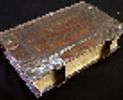
Picture: The Prophet Isaiah,
By Benjamin West.
The O Antiphons, also known as 'The great Os' are Magnificat antiphons. Each of the last 7 days of Advent we look at one of the names of Jesus and one of his attributes written about in the Bible. Each one is sung as an opening followed by Mary's Song the Magnificant, taken from her speech when she met her Aunt Elizabeth after the visit of the angel Gabrial.
The first one is O Sapientia (O Wisdom). I managed to get a translation of it in English, it is usually sung in Latin, but better understood here in English. The English Translations which mainly come from the Anglican Liturgy are not always literal translations of the Latin, the meaning and comprehension being the important factors.
They are a very old tradition dating back to the very early church. For Centuries Canonical hours have marked the divisions of the day in terms of periods of fixed prayer at regular intervals, like we have here on Prayer 7’s. The prayer books that they used for this back in medieval times have recorded the 7 (there's that number) O Antiphons and some others in some cases. So this entire website is really a modern version of a very old tradition. The O Antiphons are traditionally sung or recited at Vespers and as Allelua verses in the Roman Catholic Mass.
The Advent song/hymn, ‘O Come, O Come Emmanuel’ is a version of all the antiphons containing the meaning and lyrics of all 7 of them. Not only is each one a title and attribute of the Messiah but each one is tied to a prophecy given by the prophet Isaiah. O Sapientia (O Wisdom) is based on two verses in Isaiah.

 Welcome
Welcome Calendar
Calendar Today's Word
Today's Word Lauds
Lauds Terce
Terce Sext
Sext None
None Vespers
Vespers Compline
Compline Matins
Matins
